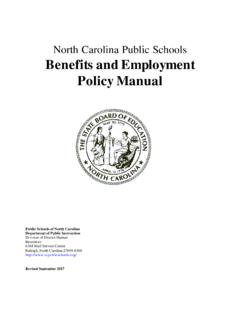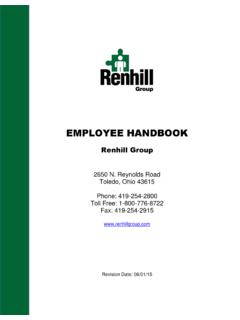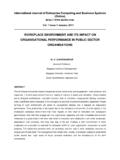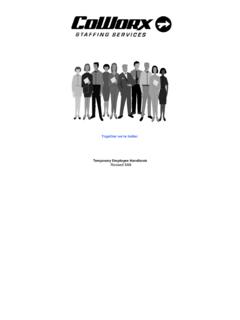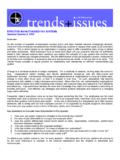Transcription of Effects of Pay and Work Environment on Employee …
1 International Journal of Scientific and Research Publications, Volume 5, Issue 4, April 2015 1 ISSN 2250-3153 Effects of Pay and work Environment on Employee Retention: A Study of Hotel Industry in Mombasa County David Mwakidimi Msengeti*, Dr. Joseph Obwogi** *School of Human Resource Development, Jomo Kenyatta University of Agriculture and Technology, **Registrar AP, Technical University of Mombasa Abstract- Travel and Tourism Industry is one of the fastest growing industry in the world contributing a colossal US $6 trillion dollars in 2011 and creating 5 million new jobs (Travel and Tourism Economic Impact Report, 2012). Hospitality sector is one of the main pillars of this industry in Kenya which has generally continued to experience phenomenal growth both in terms of revenues generated and infrastructure to support the industry. Its phenomenal growth has come along with fierce competition among the players in the industry for the limited human resource available.
2 Increased ability to retain their current employees has therefore become a very important objective for most employers in this sector. This study seeked to identify the Effects of the pay and work Environment on the retention of employees in the Hotel Industry in Mombasa County. Findings revealed that pay had a weak influence on Employee retention while work Environment had the strongest influence which was significant at (p = .005) 2-tailed. While it was evident from the results that work Environment plays a major role in Employee retention, to remain competitive it was recommended that employers in the industry also need to re-evaluate the current weaknesses associated with pay. Index Terms- Employee Retention, Employee Rewards, Pay, work Environment I. INTRODUCTION he Hotel Industry plays an important and crucial role in the development of Kenya.
3 By the year 2006, it was contributing Kshs. 87 billion to the revenues of Kenya representing of the country s Gross Domestic Product, (Ministry of Tourism Plan 2006). The growth of this industry in Kenya is closely linked to the growth of Tourism in general in the Country. In the 1960 s to the late 1980 s respectable growth in this industry was recorded thanks to the tremendous foreign investment and the attraction into Kenya of a lot of tourists during this period. The 90 s was however a period of heavy decline in the hotel industry due to the decline in tourism as a result of a combination of socio political issues that negatively impacted on the image of the country and its attractiveness as an investment destination. Since the year 2003, the industry has however experienced a turnaround of fortunes with growth and expansion being realized. This is largely due to the active role and deliberate efforts spearheaded by the Administration of His Excellence President Mwai Kibaki, the former president of the republic of Kenya, who took over power in the year 2003.
4 Employee Retention Employee retention could be described as the efforts by any business or organization to develop strategies and initiatives that support current staff into remaining with the organization. Retention is the ability to hold onto those employees you would want to keep for longer than your competition (Johnson, 2000). Success or otherwise of an organization in retaining its Employee s is measured in terms of Employee Retention Rate (ERR) or through assessment of the Employee Turnover Rate (ETR).High Employee retention rate means that Employee turnover rate has been low and vice versa. All organizations will therefore always seek and strive to maintain high rates of Employee retention (ER)-especially of their key talents, thus maintaining low levels of staff turnover. Ability of an organization to retain its employees has two-fold implications.
5 Organizations that retain their high performers are bound to be successful in performance and at the same time avoid expenses that are incurred in advertisement of vacant positions, recruitment and selection, induction and training new employees that follow and Employee lost (Okioga, 2012). From studies conducted it is suggested that the cost of Employee turnover often ranges from 50% to 200% of an Employee s annual salary based on the type and level of job he/she holds, (World atWork,2012). In the hotel industry, low Employee retention rates have been observed to interfere and disrupt the internalization of standards by the employees thus resulting to lower quality of service, reduced customer satisfaction and making an establishment less competitive.(Kimungu& Maringa, 2010). II. STATEMENT OF THE PROBLEM The Hotel Industry in Kenya has steadily recorded positive expansion in the last decade with the establishment of new facilities as a result of increased investment from both local and international investors.
6 This has been observed in the all the traditional tourist areas of Nairobi, the game parks such as Masai Mara and also Mombasa. According to the Economic Survey of 2007 and the Tourism Performance Review of 2010, hotel capacity as defined by the bed nights available in a given year has been steadily increasing from million bed nights available in 2003 to million bed nights available in 2011. T International Journal of Scientific and Research Publications, Volume 5, Issue 4, April 2015 2 ISSN 2250-3153 This increase in capacity has been achieved through the construction of new hotel facilities and the re-opening of facilities which had been closed in the 1990 s and the early 2000. With this expansion in the hotel industry, Managements of most facilities are increasingly facing the challenge of increased staff turnover with new entrants in the industry constantly poaching employees from other already existing hotel facilities.
7 In a research conducted by Kuria, et al in 2011, labour turnover rates of 68% and 13% in three star and five star rated hotels respectively were observed in Nairobi. This challenge of high turnover is being experienced despite managements of hotel facilities initiating and implementing various strategies including: offering career advancements opportunities especially for key talent among other initiatives in order to help retain their employees. While previous studies on Employee retention in the hotel industry and which have presented rewards as playing a critical role in Employee turnover have been conducted in other industries including the hotel industry in other areas, there is no such research conducted to appreciate the effect of the various components of reward on Employee retention in the hotel industry in Mombasa County Tourism area.
8 III. OBJECTIVES OF THE STUDY General Objective The general objective of this research therefore was to examine the Effects of pay and work Environment on Employee retention of hotel workers in the Hotel Industry in Mombasa County tourism area. Specific Objectives 1. To examine the effect of Pay on Employee retention in the Hotel Industry in Mombasa County tourism area. 2. To determine the Effects of work Environment on Employee retention in the Hotel Industry in Mombasa County tourism area. Significance of the Study The findings of this research would be critical in shaping the HRM practice of hotels in the Mombasa County tourism area and specifically with regard to the design and implementation of reward strategies and systems. Scope of the Study The scope of the study involved all the hotels within the Mombasa County. It was also limited in scope to investigating the effect of reward systems on Employee retention in the hotels in Mombasa Count IV.
9 LITERATURE REVIEW Pay Pay consists of cash compensations which are directly provided by employers for the work performed by the employees. Pay consists of two main elements the base pay which is compensation given on the basis of some pre-defined rates amount of time spent on the job by the Employee such as hourly weekly rates and pay contingent on the Employee s performance merit increases, incentive pay, bonus pay etc. Of this two, base pay forms the largest component of the total reward package for most employees, (Green, 2010). Base Pay Base pay may be expressed as an annual, weekly or hourly rate. The hourly rate is sometimes called the time rate system of payment. Base pay is categorized into either job-based pay where the base is related entirely to the value of the job rather than the person. On the other hand where the base pay is adjusted to take into account the levels of competency or skills it s known as person based pay.
10 (Armstrong, 2012).Job evaluation initiatives in determining base pay are intended to cater for internal relativities in arriving at the base pay levels while market survey and tracking of market rates are used for assessing external relativities that help in determining competitive base pay rates. Contingency Pay Contingent pay is a nimble instrument that allows employers to pay for results they want by giving money to those who are fully contributing to the business objectives (Zingheim& Schuster, 2007). Thus unlike base pay, contingent pay and accompanying decisions are usually in line with the performance levels or desired results/ aspect achieved or exhibited by the employees. In contingency pay based on performance also referred to as Performance Related Pay (PRP), the consolidated pay increases or cash bonuses are based on the achievement of some agreed target by the Employee (s) at the end of a stipulated period.










